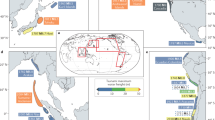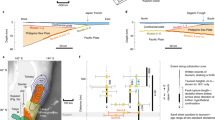Abstract
The great Sumatra–Andaman earthquake and Indian Ocean tsunami of 2004 came as a surprise to most of the earth science community. Although it is now widely recognized that the risk of another giant earthquake is high off central Sumatra1, just east of the 2004 earthquake, there seems to be relatively little concern about the subduction zone to the north, in the northern Bay of Bengal along the coast of Myanmar. Here I show that similar indicators suggest a high potential for giant earthquakes along the coast of Myanmar. These indicators include the tectonic environment, which is similar to other subduction zones that experience giant megathrust earthquakes, stress and crustal strain observations, which indicate that the seismogenic zone is locked, and historical earthquake activity, which indicates that giant tsunamigenic earthquakes have occurred there in the past. These are all consistent with active subduction in the Myanmar subduction zone and I suggest that the seismogenic zone extends beneath the Bengal Fan. I conclude therefore that giant earthquakes probably occur off the coast of Myanmar, and that a large and vulnerable population is thereby exposed to a significant earthquake and tsunami hazard.
This is a preview of subscription content, access via your institution
Access options
Subscribe to this journal
Receive 51 print issues and online access
$199.00 per year
only $3.90 per issue
Buy this article
- Purchase on Springer Link
- Instant access to full article PDF
Prices may be subject to local taxes which are calculated during checkout


Similar content being viewed by others
References
Natawidjaja, D. H. et al. Source parameters of the great Sumatra megathrust earthquakes of 1797 and 1833 inferred from coral microatolls. J. Geophys. Res. 111 doi: 10.1029/2005JB004025 (2006)
Satyabala, S. P. Subduction in the Indo-Burma region: Is it still active? Geophys. Res. Lett. 25, 3189–3192 (1998)
Guzmn-Speziale, M. & Ni, J. F. Comment on “Subduction in the Indo-Burmese region: Is it still active?” by S. P. Satyabala. Geophys. Res. Lett. 27, 1065–1066 (2000)
Le Dain, A. Y., Tapponier, P. & Molnar, P. Active faulting and tectonics of Burma and the surrounding regions. J. Geophys. Res. 89, 453–472 (1984)
Ni, J. F. et al. Accretionary tectonics of Burma and the three-dimensional geometry of the Burma subduction zone. Geology 17, 68–71 (1989)
Kamesh Raju, K. A., Murty, G. P. S., Amarnath, D. & Mohan Kumar, M. L. The west Andaman fault and its influence on the aftershock pattern of the recent megathrust earthquakes in the Andaman-Sumatra region. Geophys. Res. Lett. 34 doi: 10.1029/2006GL028730 (2007)
Scholl, D. Sediment influx to subduction zone and great magnitude earthquakes; an observational appraisal. In Tsunami Sources Workshop Proceedings (US Geological Survey, Menlo Park, California, 21–22 April 2006)
Alam, M., Alam, M. M., Curray, J. R., Rahman Chowdhury, M. L. & Royhan Gani, M. An overview of the sedimentary geology of the Bengal Basin in relation to the regional tectonic framework and basin-fill history. Sedim. Geol. 155, 179–208 (2003)
Wang, K., Hyndman, R. D. & Yamamoto, M. Thermal regime of the southwest Japan subduction zone: effects of age history of the subducting plate. Tectonophysics 248, 53–69 (1995)
Kahn, A. A. Tectonics of the Bengal Basin. J. Himal. Geol. 2, 91–101 (1991)
Acharyya, S. Break-up of the greater Indo-Australian continent and accretion of blocks framing south and east Asia. J. Geodyn. 26, 149–170 (1998)
Nielson, C., Chamot-Rooke, N. & Rangin, C. & the ANDAMAN Cruise Team. the ANDAMAN Cruise Team. From partial to full strain partitioning along the Indo-Burmese hyper-oblique subduction. Mar. Geol. 209, 303–327 (2004)
Gowd, T. N., Srirama Rao, S. V. & Gaur, V. K. Tectonic stress field in the Indian subcontinent. J. Geophys. Res. 97, 11879–11888 (1992)
Socquet, A. et al. India and Sunda plates motion and deformation along their boundary in Myanmar determined by GPS. J. Geophys. Res. 111 doi: 10.1029/2005JB003877 (2006)
Wang, K. & He, J. Mechanics of low stress forearcs: Nankai and Cascadia. J. Geophys. Res. 104, 15191–15206 (1999)
Ruff, L. Do trench sediments affect great earthquake occurrence in subduction zones? Pure Appl. Geophys. 129, 263–282 (1989)
Vigny, C. et al. Present-day crustal deformation around Sagaing fault, Myanmar. J. Geophys. Res. 108 doi: 10.1029/2002JB001999 (2003)
Halsted, E. P. Report on the Island of Cheduba. J. Asiatic Soc. Bengal 114, 319–446 (1843)
Hirst, W. An Account of an Earthquake at Chattigaon: translated from the Persian by Mr. Edward Gulston, in the Service of the Honourable East India Company, and Communicated by Him to the Reverend Mr. Hirst. Phil. Trans. R. Soc. Lond. 8, 251 (1763)
Oldham, T. A catalogue of Indian earthquakes from the earliest time to the end of A.D. 1869. Mem. Geol. Surv. India 19, 163–215 (1883)
Ando, M. Source mechanisms and tectonic significance of historical earthquakes along the Nankai Trough, Japan. Tectonophysics 27, 119–140 (1975)
Chavez, M. & Castro, R. Attenuation of Modified Mercalli Intensity with distance in Mexico. Bull. Seismol. Soc. Am. 78, 1875–1884 (1988)
Acknowledgements
Among the many colleagues at Geoscience Australia who offered support and advice, I especially thank C. Collins for discussions about the 1762 Arakan earthquake and Bengal during the colonial era, and M. Hollow for help locating many of the historical references. I am also grateful to K. Sieh and C. Vigny for their thorough and constructive reviews.
Author information
Authors and Affiliations
Corresponding author
Ethics declarations
Competing interests
Reprints and permissions information is available at www.nature.com/reprints. The authors declare no competing financial interests.
Rights and permissions
About this article
Cite this article
Cummins, P. The potential for giant tsunamigenic earthquakes in the northern Bay of Bengal. Nature 449, 75–78 (2007). https://doi.org/10.1038/nature06088
Received:
Accepted:
Issue Date:
DOI: https://doi.org/10.1038/nature06088
This article is cited by
-
Oblique plate convergence along arcuate trenches on a spherical Earth. An example from the Western Sunda Arc
Acta Geophysica (2023)
-
Central shutdown and surrounding activation of aftershocks from megathrust earthquake stress transfer
Nature Geoscience (2022)
-
Stepwise, earthquake-driven coastal subsidence in the Ganges–Brahmaputra Delta (Sundarbans) since the eighth century deduced from submerged in situ kiln and mangrove remnants
Natural Hazards (2022)
-
Modelling the seismic potential of the Indo-Burman megathrust
Scientific Reports (2021)
-
Sand deposits reveal great earthquakes and tsunamis at Mexican Pacific Coast
Scientific Reports (2020)
Comments
By submitting a comment you agree to abide by our Terms and Community Guidelines. If you find something abusive or that does not comply with our terms or guidelines please flag it as inappropriate.



